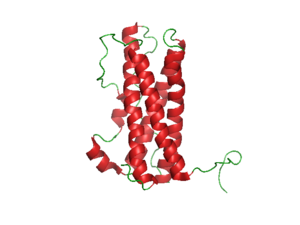Hyperprolactinemia
| Hyperprolactinemia | |
|---|---|
 |
|
| Prolactin | |
| Classification and external resources | |
| Specialty | Endocrinology |
| ICD-10 | E22.1 |
| ICD-9-CM | 253.1 |
| DiseasesDB | 6314 |
| eMedicine | med/1098 |
| MeSH | D006966 |
Hyperprolactinaemia or hyperprolactinemia is the presence of abnormally high levels of prolactin in the blood. Normal levels are less than 500 mIU/L [20 ng/mL or µg/L] for women, and less than 450 mIU/L for men.
Prolactin is a peptide hormone produced by the anterior pituitary gland that is primarily associated with lactation and plays a vital role in breast development during pregnancy. Hyperprolactinaemia may cause galactorrhea (production and spontaneous flow of breast milk) and disruptions in the normal menstrual period in women and hypogonadism, infertility and erectile dysfunction in men.
Hyperprolactinaemia can be a part of normal body changes during pregnancy and breastfeeding. It can also be caused by diseases affecting the hypothalamus and pituitary gland. It can also be caused by disruption of the normal regulation of prolactin levels by drugs, medicinal herbs and heavy metals. Hyperprolactinaemia may also be the result of disease of other organs such as the liver, kidneys, ovaries and thyroid.
In women, a high blood level of prolactin often causes hypoestrogenism with anovulatory infertility and a decrease in menstruation. In some women, menstruation may disappear altogether (amenorrhoea). In others, menstruation may become irregular or menstrual flow may change. Women who are not pregnant or nursing may begin producing breast milk. Some women may experience a loss of libido (interest in sex) and breast pain, especially when prolactin levels begin to rise for the first time, as the hormone promotes tissue changes in the breast. Intercourse may become difficult or painful because of vaginal dryness.
...
Wikipedia
